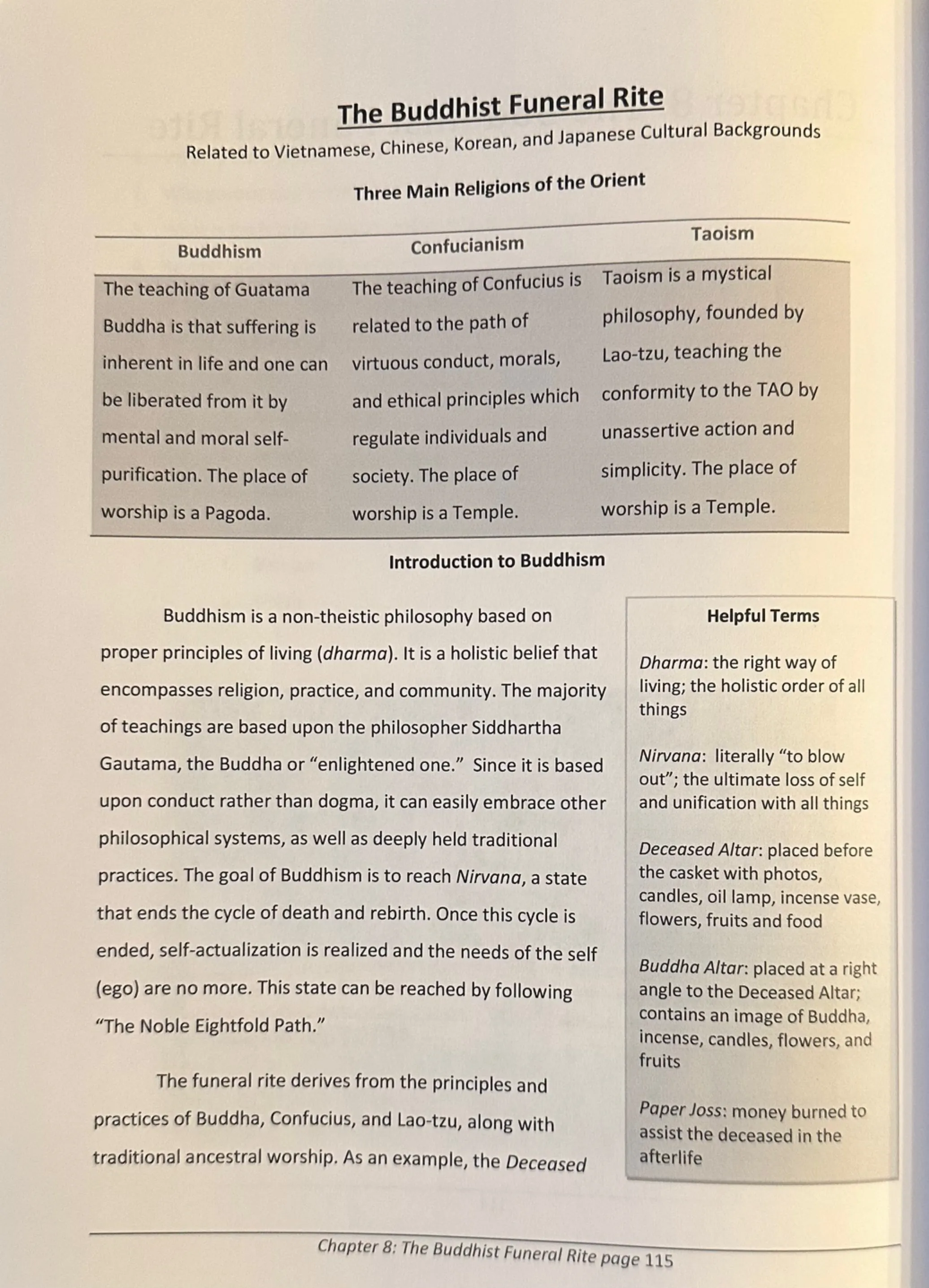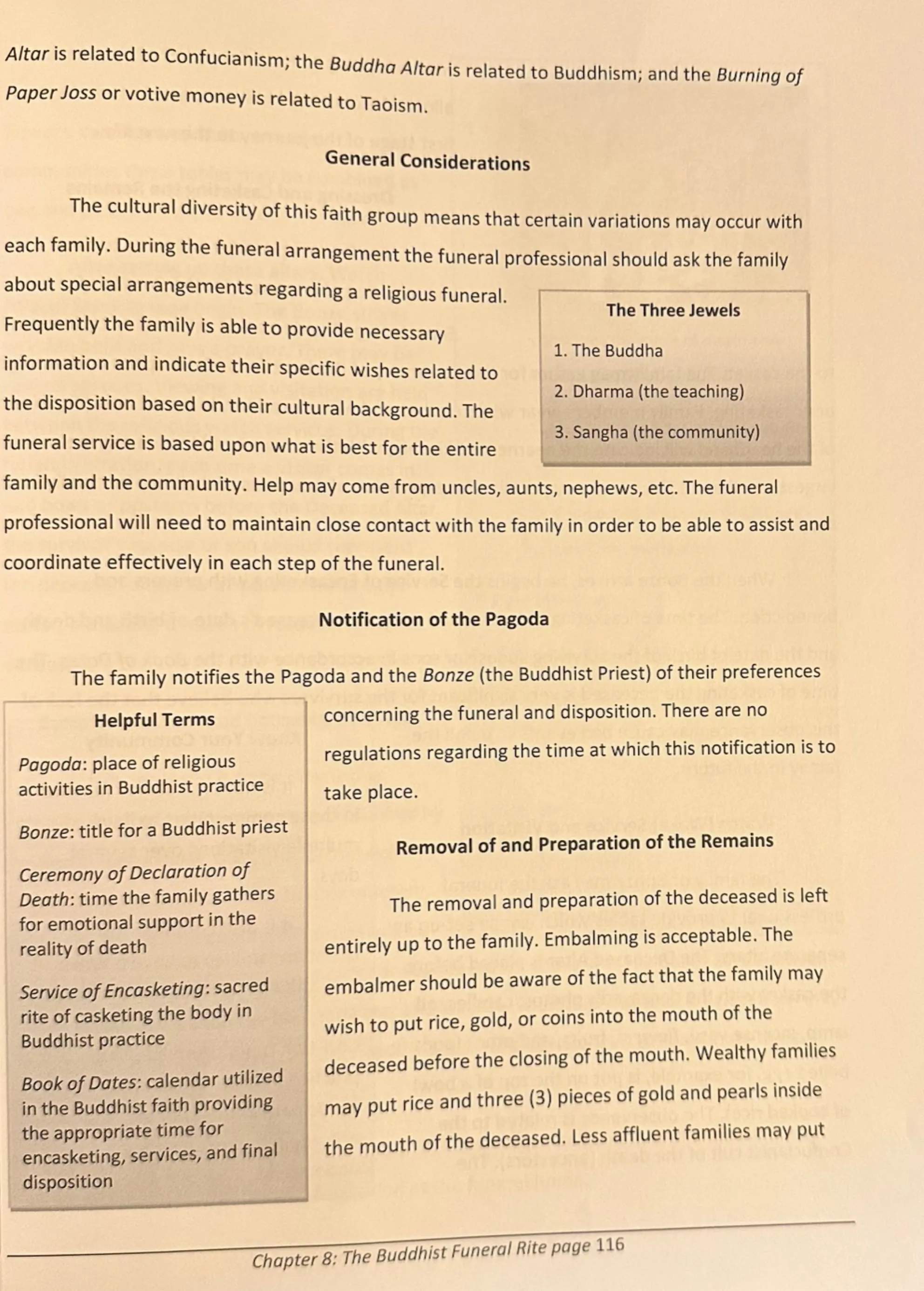The Buddhist Funeral Rite: Origins, Practices, and Key Terms
Document from University about The Buddhist Funeral Rite. The Pdf explores the origins and practices of the Buddhist funeral rite, including influences from Confucianism and Taoism. It defines key terms like Dharma and Nirvana, detailing the stages from preparing the deceased to post-burial services, suitable for university-level Religion studies.
See more14 Pages


Unlock the full PDF for free
Sign up to get full access to the document and start transforming it with AI.
Preview
The Buddhist Funeral Rite
Related to Vietnamese, Chinese, Korean, and Japanese Cultural Backgrounds
Three Main Religions of the Orient
Taoism Buddhism Confucianism
The teaching of Guatama The teaching of Confucius is Taoism is a mystical Buddha is that suffering is related to the path of philosophy, founded by inherent in life and one can virtuous conduct, morals, Lao-tzu, teaching the be liberated from it by and ethical principles which conformity to the TAO by mental and moral self- regulate individuals and unassertive action and purification. The place of society. The place of simplicity. The place of worship is a Pagoda. worship is a Temple. worship is a Temple.
Introduction to Buddhism
Buddhism is a non-theistic philosophy based on proper principles of living (dharma). It is a holistic belief that encompasses religion, practice, and community. The majority of teachings are based upon the philosopher Siddhartha Gautama, the Buddha or "enlightened one." Since it is based upon conduct rather than dogma, it can easily embrace other philosophical systems, as well as deeply held traditional practices. The goal of Buddhism is to reach Nirvana, a state that ends the cycle of death and rebirth. Once this cycle is ended, self-actualization is realized and the needs of the self (ego) are no more. This state can be reached by following "The Noble Eightfold Path."
The funeral rite derives from the principles and practices of Buddha, Confucius, and Lao-tzu, along with traditional ancestral worship. As an example, the Deceased Helpful Terms Dharma: the right way of living; the holistic order of all things Nirvana: literally "to blow out"; the ultimate loss of self and unification with all things Deceased Altar: placed before the casket with photos, candles, oil lamp, incense vase, flowers, fruits and food Buddha Altar: placed at a right angle to the Deceased Altar; contains an image of Buddha, incense, candles, flowers, and fruits Paper Joss: money burned to assist the deceased in the afterlife Chapter 8: The Buddhist Funeral Rite page 115Altar is related to Confucianism; the Buddha Altar is related to Buddhism; and the Burning of Paper Joss or votive money is related to Taoism.
General Considerations for Buddhist Funerals
The cultural diversity of this faith group means that certain variations may occur with each family. During the funeral arrangement the funeral professional should ask the family about special arrangements regarding a religious funeral.
Frequently the family is able to provide necessary The Three Jewels information and indicate their specific wishes related to 1. The Buddha the disposition based on their cultural background. The 2. Dharma (the teaching) funeral service is based upon what is best for the entire 3. Sangha (the community) family and the community. Help may come from uncles, aunts, nephews, etc. The funeral professional will need to maintain close contact with the family in order to be able to assist and coordinate effectively in each step of the funeral.
Notification of the Pagoda
The family notifies the Pagoda and the Bonze (the Buddhist Priest) of their preferences Helpful Terms Pagoda: place of religious activities in Buddhist practice Bonze: title for a Buddhist priest Ceremony of Declaration of Death: time the family gathers for emotional support in the reality of death Service of Encasketing: sacred rite of casketing the body in Buddhist practice Book of Dates: calendar utilized in the Buddhist faith providing the appropriate time for encasketing, services, and final disposition concerning the funeral and disposition. There are no regulations regarding the time at which this notification is to take place.
Removal and Preparation of the Remains
The removal and preparation of the deceased is left entirely up to the family. Embalming is acceptable. The embalmer should be aware of the fact that the family may wish to put rice, gold, or coins into the mouth of the deceased before the closing of the mouth. Wealthy families may put rice and three (3) pieces of gold and pearls inside the mouth of the deceased. Less affluent families may put Chapter 8: The Buddhist Funeral Rite page 116new or shining coins in the mouth. This practice allows the deceased to have provisions during the first stage of the journey to the next life.
Dressing and Casketing the Remains
The funeral provider will need to have a room or chapel prepared for the Service of Encasketing. The deceased will be on a table close to the casket. The family may gather for the Ceremony of Declaration of Death prior to dressing or encasketing. Family members wear white clothes and white headbands or turbans. (The size of the headband will indicate the nearness of kinship, with the nearest of kin wearing the largest headband.) This ceremony permits the expression of emotions and allows for family support.
When the Bonze arrives, he begins the Service of Encasketing with prayers and benediction. The time of casketing is determined using the deceased's date of birth and death and the date of birth of the surviving spouse or sons in accordance with the Book of Dates. The time of casketing the deceased is very significant for the survivors who believe that the lack of this observance may cause bad events to befall the Know Your Community family in the future.
Watch (Wake) Service and Visitation
The family or Bonze may ask the funeral professional to provide tables which can be set-up as separate altars. The Deceased Altar is placed before the casket with the deceased's photos, candles, oil lamp, incense vase, flowers, fruits, and other foods (a boiled egg, for example, is put on the top of a bowl of cooked rice). The observance is related to the Confucianist cult of the death (ancestors). The It is not unusual for families in these communities to have multiple visitations over several days. It is also common for Christian families to have a Wake with the elements of the Deceased Altar, and yet have a traditional Christian funeral service. This practice permits the community to participate in the grief process according to customs they understand. Chapter 8: The Buddhist Funeral Rite page 117Buddha Altar is usually placed at right angles to the Deceased Altar and contains incense, flowers, candles, and fruits. In some communities these tables may be combined as one and placed on either side of the casket.
After setting up these altars, Watch (Wake) Services may begin. The Bonze strikes wooden bells and says a prayer. There may be several services. Viewing and visitation are held between the religious watch services. During the funeral visitation, each time a visitor comes in and bows or posterns before the Deceased Altar the survivor's spouse or son should represent the deceased and bow or postern before the visitor, indicating a return of respect from the deceased.
Burial Procession and Committal Service
The Noble Eightfold Path
- Right View (based on the Four Noble Truths) A. All things are temporary and unfulfilling (Dukkha). B. Clinging to temporal things continues the cycle of death and rebirth (the Start of Dukkha). C. Ceasing these desires will end the cycles of rebirth (the End of Dukkha). D. Follow Buddha in self denial, self- control, and meditation.
- Right Intention
- Right Speech
- Right Action
- Right Livelihood
- Right Effort
- Right Mindfulness
- Right Concentration
If the deceased is to be interred or entombed, when the day and time prescribed by the Bonze has arrived, the burial procession moves from the funeral home to the cemetery, led by the Bonze. The committal service will be held at the place of interment, cemetery or pagoda. At the graveside, the Bonze says a prayer and gives Final Benediction with holy water and incense. Friends or fraternal organizations may give a eulogy for the deceased at this stage. The funeral professional is to coordinate these activities.
Cremation is encouraged and, should final disposition be by means of cremation, the Committal Service is held prior to cremation at the funeral home.
Post Burial Services
Post burial services are held at the home or the Pagoda. There are seven of these services - one per week for seven weeks (49 days). This observance is very significant because these services help the deceased's soul to pass and go through the best reincarnation.
Mourning Period
The mourning period depends upon the range of closeness of individuals to the deceased. This may vary from six months to three years. Mourners are expected to refrain from festivities and amusement during this time. When working, mourners may wear a black ribbon on the chest or a black band on the left arm as a sign of mourning.
Order of Service
Tolling of the temple bell Procession:
- Minister(s)
- Casketbearers
- Funeral Director
- Casket (Head end first)
- Funeral Director
Chanting of sutras before the casket by the officiant Presentation of Buddhist name: A posthumous name is conferred upon the deceased by the minister, signifying that he has begun his new existence in the Nirvana. Offering of incense: Several incense burners with bowls of ground-up incense alongside will be placed before the altar. This is the most significant expression in the Buddhist religion, always followed by a quick recitation of spiritual cleansing of the soul and the transference of one's mortality to Nirvana. The order of the offering begins with the immediate family, followed by other relatives, casketbearers, and finally, the congregation. Gatha: The first two verses of a Buddhist hymn will be sung at this time. Opening remarks Eulogy Sermon Gatha: The last two verses of the hymn will be sung. Condolence Message: A condolence message is read to the family on behalf of the congregation. Words of Appreciation: A representative from the family will speak in response to the condolence message from the congregation. (This is usually a very brief expression of appreciation to the congregation for their presence at the service.) Recessional:
- Ministers
- Casketbearers
- Funeral Director
- Casket (Foot end first)
- Funeral Director
- Family
- Congregation